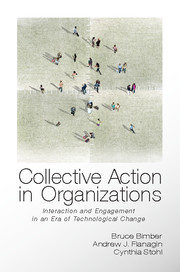Book contents
- Frontmatter
- Contents
- List of Figures and Tables
- Preface
- 1 Involvement in Organizational Collective Action in an Era of Technological Change
- 2 The Contemporary Media Environment and the Evolution of Boundaries in Organization-based Collective Action
- 3 The Collective Action Space
- 4 The American Legion, AARP, and MoveOn in Collective Action Space
- 5 Exploring Collective Action Space
- 6 Participatory Styles, the Individual, and the Contemporary Organization
- Appendix a Interaction and Engagement
- Appendix b Predicting Contribution, Identification, and Trust by Organization
- Appendix c Descriptive Statistics for the Participatory Styles
- References
- Index
2 - The Contemporary Media Environment and the Evolution of Boundaries in Organization-based Collective Action
Published online by Cambridge University Press: 05 June 2012
- Frontmatter
- Contents
- List of Figures and Tables
- Preface
- 1 Involvement in Organizational Collective Action in an Era of Technological Change
- 2 The Contemporary Media Environment and the Evolution of Boundaries in Organization-based Collective Action
- 3 The Collective Action Space
- 4 The American Legion, AARP, and MoveOn in Collective Action Space
- 5 Exploring Collective Action Space
- 6 Participatory Styles, the Individual, and the Contemporary Organization
- Appendix a Interaction and Engagement
- Appendix b Predicting Contribution, Identification, and Trust by Organization
- Appendix c Descriptive Statistics for the Participatory Styles
- References
- Index
Summary
An understanding of collective action in the contemporary media environment requires a way of conceptualizing technology that is relevant to collective action. In our case, that means technology that is rapidly ramifying and collective action that takes place within organizational contexts. As we suggested in Chapter 1, it is important to avoid the pitfalls of attempting to theorize connections from such fine-grained matters as how frequently people use e-mail or a particular social-networking tool to hypothesize about a variety of behavioral outcomes. A good deal of analysis has theorized that technology use affects behavior by reducing costs or increasing choice, but those theories have typically not conceptualized behavior as being structured through organizational membership, and they also provide little purchase on differences among so many technologies, all of which in one way or another reduce costs, facilitate communication, and distribute information more widely and seamlessly. Our interest in this book is in theorizing how the digital-media environment affects behavior as well as attitudes – involvement – in a way that is not dependent on solving intractable measurement problems and that is also specified precisely to take place in organizational contexts. This will require conceptualizing technology in organization-relevant ways. Our main theoretical task is therefore to trace how features of technology shape people's experience of organizations. We will do this in several steps in this chapter and in Chapter 3 by identifying two general aspects of the contemporary media environment relevant to all collective action regardless of context, showing how these affect human boundaries of all kinds and what that means for collective action theory generally, and focusing on what these aspects of the media environment and boundaries mean inside organizations, through interaction and engagement.
- Type
- Chapter
- Information
- Collective Action in OrganizationsInteraction and Engagement in an Era of Technological Change, pp. 37 - 73Publisher: Cambridge University PressPrint publication year: 2012

